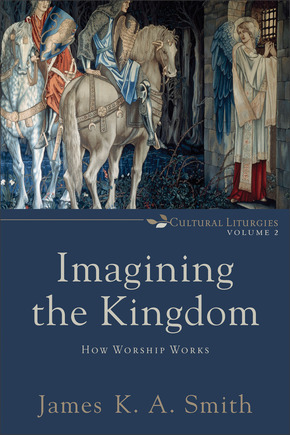Imaging the Kingdom
How Worship Works
James K. A. Smith
Grand Rapids: Baker Academic, 2013, pbk, 224 pp.
ISBN 978-0-8010-3578-4
Imagining the kingdom is the second part of a proposed trilogy exploring "cultural liturgies". In the first volume, Desiring the Kingdom (Baker Academic, 2009), Smith posed an exciting and outrageous question: "What if education wasn't first and foremost what we know, but about what we love?" In this second volume he follows this up by suggesting that "our actions emerge from how we imagine the world: "What if we are actors before we are thinkers?" (p 32). Smith's thesis is that we are defined more by what we worship than by what we think or believe. Thus we need to see more clearly how the affective affects the cognitive: to displace functional intellectualism, where what we do is the outcome of what we think.
His aim is "to articulate a Christian philosophy of action that takes seriously the creational conditions of human action: our embodiment, our finitude, our sociality, and the complexity of our being-in-the-world—the different ways that we “intend” our world." (p 33) He seeks to develop a liturgical anthropology, one that is defined but what we love (the affective), rather than how what we think or what we know (the cognitive). One that emphasises that we are not primarily theorisers.
To examine this em-body-ment, in Part 1, he looks at the work of two French academics, the philosopher Merleau-Ponty, particularly his nation of bodily intelligence and the sociologist Bourdieu, with his critique of theoretical reason. Bourdieu argues that human formation is not primarily cognitive. Part 2 "Sanctified Perception" develops and applies these "toolbox" ideas to look at how worship works.
Particularly helpful and insightful is the narrative function and role of worship. This is something that "secular" liturgies understand and utilise to shape and form us. We live in a storied world.
In essence what Smith is doing is connecting worship and worldview, he desires to make education more about formation not information, and sees liturgy - the rituals and routines that shape what we love - as playing an important part in this formation. He deftly bridges the academy and the church - the full footnotes provide the academic support for the arguments and the vignettes provide a more concrete view. Thus, the main text is interspersed with helpful examples utilising films such as Rise of the Planet of the Apes, Jane Campion's Bright Star, The King's Speech and novels like David Foster Wallace's Infinite Jest and Nicholson Baker's The Mezzanine.
His final chapter deals with the importance of ritual and liturgy in formation. Interestingly he identifies repetition in liturgy as being important.
Smith is not afraid of plundering Egypt - or in his case French theorists - he identifies what that have learnt because of common grace. His is a transformative approach.
This liturgical anthropology Smith develops is important not only for academics but for all Christian educators, from infant through to postgraduate level, as well as for pastors and church worship leaders. We are liturgical creatures, "sacramental animals"; we love what we worship. Worship, then is an encounter and a formation. I look forward to the third part of this so-far excellent trilogy.
Subscribe to:
Post Comments (Atom)


No comments:
Post a Comment